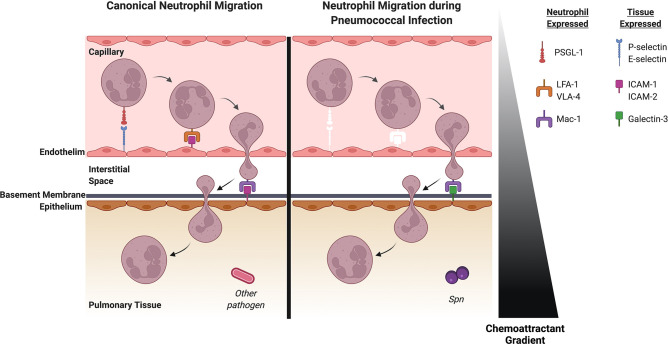Figure 1.
Neutrophil recruitment in the lung during pneumococcal pneumonia differs from canonical neutrophil recruitment to the lung. Left: Canonical neutrophil recruitment into pulmonary tissue. Selectins impart weak interactions between the endothelium and neutrophil which allows tethering by the integrin PSGL-1. LFA-1 and VLA-4 on the neutrophil then interact with ICAM-1 and ICAM-2 on the endothelial surface allowing the neutrophil to cross the endothelium. ICAM-1 and ICAM-2 also allows the neutrophil to bind to the epithelium via the integrin Mac-1 and subsequently migrate into the pulmonary space. Right: Neutrophil recruitment to the lung during Spn infection. White molecules represent factors that are important for canonical neutrophil recruitment but do not play a role in pneumococcal pneumonia. Selectins are dispensable for neutrophil recruitment for pneumococcal pneumonia. Mechanical entrapment in the thinner vessels likely plays a role in initial attraction of the neutrophil to the endothelium. The canonical integrin-ligand pairs that allow the neutrophil to bind to the endothelium seem to be non-essential in pneumococcal pneumonia, so unknown ligands and integrins on the endothelium and the neutrophil may play a role here. Once the neutrophil is in the interstitial space, ligands on the epithelium capture the neutrophil. Although canonical ligands like ICAM-1 and ICAM-2 have been shown to be indispensable here, Galectin-3 has a significant role in subsequent movement of the neutrophil into the pulmonary space. Spn, Streptococcus pneumoniae. Created with BioRender.com.

